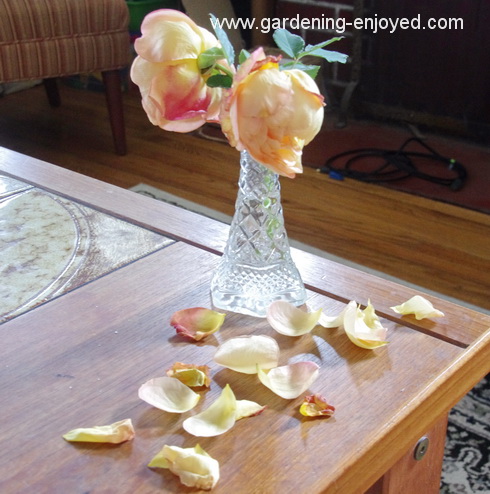
It appears that almost a whole month has slipped by since I last published “Dallying.” Now The Assistant Gardener is pointing out the two Roses on our coffee table as they start to fall apart and asks if they are the last Rose of Summer. Yes, and it would appear that they are the last Rose of this strange year 2020. We have finally had our first frost for two nights running and barely above freezing for most of today. Now there is a whole host of new chores awaiting me in the garden. It will be a change from the almost daily chore helping the squirrels deal with the biggest Walnut harvest we can remember. That’s one of the reasons for the month long gap, writing about Walnut clean up would probably be even less interesting than reading about it. The last two frosty and windy nights have completely denuded the Walnut tree and we spent some time over the weekend gathering the harvest. Now the word harvest usually means the gathering of some useful crop and thus I am
using it incorrectly as there is nothing useful about this pile of nuts, except for feeding the squirrels, not an activity that is high on my list. Luckily we have a municipal garden waste pickup every other week and I feel guilty as I pile those large brown paper bags at the end of the walk. Most houses have them filled with leaves, which they should be adding to their gardens, but ours are “noticeably” heavier due to the Walnut content. If the bottom 15 cm was just Walnuts it would be close to my ability to carry. Enough with the Walnuts, there are a couple of Roses with blooms on them despite the frost and it will be interesting to see if the few buds showing will develop as the weather warms this week.
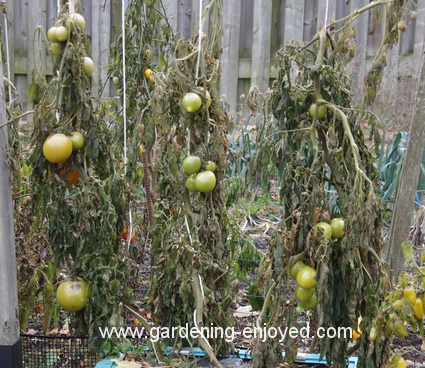
With the obvious effects of the frost staring at me from all corners of the garden, the job list has just expanded rapidly. These Tomatoes have certainly seen better days and are on their way to the compost. No! I don’t regret not picking those big beauties because I already have too many in the house. Mandarin Cross from Renees Seeds was a delicious and prolific producer in the garden all season and is sure to stay on our permanent list for a few years. It was a bright orange colour that was a treat to see in the garden or on a plate. All of these and most of the other finished material from the vegetable garden goes into the compost. Occasionally a few Tomato seeds survive being composted and show up as volunteers in a future garden. We try to exclude weeds from the compost for
the same reason. Many weed seeds seem to survive and return to haunt us in future years so now most weeds find their way to the municipal compost system. Just across the garden from these Tomatoes are the very frosted Dahlias. For a plant that comes into its own late in the season, providing us with an abundance of cut flowers, it turns a very dark and dismal black at the first frost. Luckily the tubers are still fine in the warm soil and digging them is also on this week’s new job list.
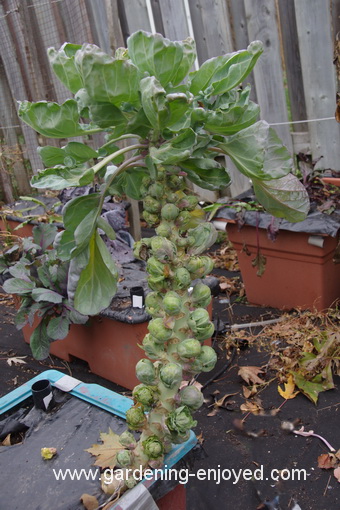 Now these Brussel’s Sprouts deal with the frost in a much better fashion. I’m always fascinated by the different plant’s ability to deal with freezing temperatures. Dahlias immediately turn to mush while the B. Sprouts growing right beside them show no visible effects at all. The Sprouts are affected by that frost. It somehow signals the plant to get ready for winter by converting its starch content into sugars and that’s why we wait until now to start harvesting them. That slightly bitter taste is replaced with a more pleasing sweetness. They will be gracing our dinner plates on a regular basis for the next few weeks. Have you ever tried them with a little Hollandaise sauce?
Now these Brussel’s Sprouts deal with the frost in a much better fashion. I’m always fascinated by the different plant’s ability to deal with freezing temperatures. Dahlias immediately turn to mush while the B. Sprouts growing right beside them show no visible effects at all. The Sprouts are affected by that frost. It somehow signals the plant to get ready for winter by converting its starch content into sugars and that’s why we wait until now to start harvesting them. That slightly bitter taste is replaced with a more pleasing sweetness. They will be gracing our dinner plates on a regular basis for the next few weeks. Have you ever tried them with a little Hollandaise sauce?
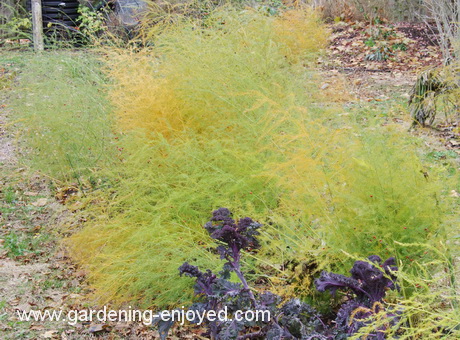
We eat white Asparagus occasionally, created by keeping the sun off the emerging spears. Green Asparagus is plentiful for a month or more in the spring but this is yellow Asparagus. These lovely green fern like plants spend the summer rejuvenating the roots and then suddenly, almost like someone turned a switch, they will turn completely yellow in a few days. That signals another addition to our autumn job list. All of that yellow foliage must be cut down and bagged. This is one vegetable that I don’t put in my compost. The little purplish scales that we are familiar with on those delicious spears, get quite rigid and sharp by this time of year. I have learned over the years that they don’t readily break down in a compost heap but hide in that compost looking for unsuspecting fingers to penetrate. If I could get my compost hotter they would probably break down but I just take the easy route and put them by the roadside in those brown bags.
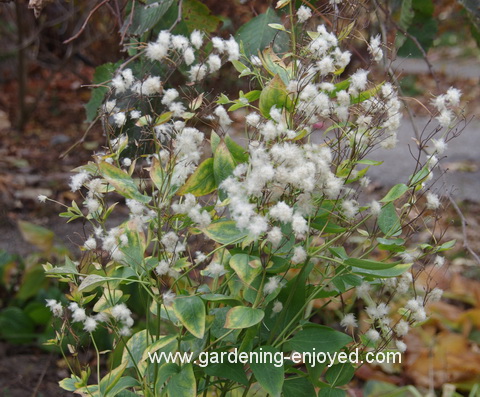
Some plants really are two season plants. This is a shrubby Clematis that reached about 1.5 m tall and had small purple flowers with very showy white stamens for much of the summer. Here we are in its second season when the fluffy white seed heads are putting on a show in a garden that has surrendered much of its beauty to the frost. It’s new to this garden and has easily earned its spot but the term shrubby leaves a little to be desired. It did need some significant support which it got this year from a circle of hardware cloth around it. I need to create a little trellis or obelisk for it so that it is able to spread out and let us appreciate its beauty. Again I am fascinated about how green and healthy it looks after the frost when the trellis of Morning Glories beside it has turned into a pile of mush. I should have taken that plant
physiology course.
To ask a question just “reply” to this ezine. Don’t forget to check the front page of the Website for frequent short ideas for current gardening activities.
Elizabeth Asks? What to use for severe powdery mildew on my phlox and lately the peony bushes?
Ken Answers!The powdery mildew on the Peony doesn't do any real harm and only appears late in the season, I just ignore it or cut down and compost the foliage. On the Phlox it, again, does little actual harm but it does appear earlier and can be unsightly. There are some mildew resistant varieties you might try. There really are no commercial sprays available but I use a mix of 1 part milk to 8 parts water as a spray on Begonias and Squash and it works reasonably well.
|

 Now these Brussel’s Sprouts deal with the frost in a much better fashion. I’m always fascinated by the different plant’s ability to deal with freezing temperatures. Dahlias immediately turn to mush while the B. Sprouts growing right beside them show no visible effects at all. The Sprouts are affected by that frost. It somehow signals the plant to get ready for winter by converting its starch content into sugars and that’s why we wait until now to start harvesting them. That slightly bitter taste is replaced with a more pleasing sweetness. They will be gracing our dinner plates on a regular basis for the next few weeks. Have you ever tried them with a little Hollandaise sauce?
Now these Brussel’s Sprouts deal with the frost in a much better fashion. I’m always fascinated by the different plant’s ability to deal with freezing temperatures. Dahlias immediately turn to mush while the B. Sprouts growing right beside them show no visible effects at all. The Sprouts are affected by that frost. It somehow signals the plant to get ready for winter by converting its starch content into sugars and that’s why we wait until now to start harvesting them. That slightly bitter taste is replaced with a more pleasing sweetness. They will be gracing our dinner plates on a regular basis for the next few weeks. Have you ever tried them with a little Hollandaise sauce?


